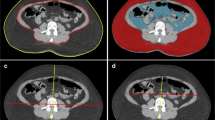Abstract
Background
The effect of obesity on gastrectomy in patients with gastric cancer is controversial. The degree of abdominal fat increases the technical difficulty of abdominal surgery. This study examined the effect of visceral fat on total gastrectomy and risk factors associated with the formation of pancreatic fistula.
Methods
Between February 2001 and April 2007, 191 patients with gastric cancer underwent total gastrectomy. The visceral fat area (VFA) was calculated from computed tomography (CT) scans taken at the level of the umbilicus using FatScan Software. Patients were divided into high- (≥100 cm2, n = 52) and low-VFA groups (<100 cm2, n = 139), and also into high- (≥25 kg/m2, n = 47) and low-BMI groups (<25 kg/m2, n = 144).
Results
Blood loss and incidence of pancreatic fistula were significantly higher in the high- than low-VFA group. However, only blood loss was significantly different between the high- and low-BMI groups. VFA, blood loss, and splenectomy were identified as significant risk factors for pancreatic fistula formation on univariate analysis, and multivariate logistic regression analysis of these factors identified VFA (p = 0.0001) and splenectomy (p = 0.0014) as significant predictors of pancreatic fistula.
Conclusions
VFA is a better indicator for pancreatic fistula formation after total gastrectomy than is BMI. Lymph node dissection must be performed carefully, especially in patients with visceral fat accumulation during total gastrectomy with splenectomy.



Similar content being viewed by others
References
Noshiro H, Shimizu S, Nagai E, et al. Laparoscopy-assisted distal gastrectomy for early gastric cancer: is it beneficial for patients of heavier weight? Ann Surg. 2003;238:680–5.
Bouchard C, Despres JP, Mauriege P. Genetic and nongenetic determinants of regional fat distribution. Endocr Rev. 1993;14:72–93.
Gretschel S, Christoph F, Bembenek A, et al. Body mass index does not affect systematic D2 lymph node dissection and postoperative morbidity in gastric cancer patients. Ann Surg Oncol. 2003;10:363–8.
Lee JH, Paik YH, Lee JS, et al. Abdominal shape of gastric cancer patients influences short-term surgical outcomes. Ann Surg Oncol. 2007;14:1288–94.
Tsujinaka T, Sasako M, Yamamoto S, et al. Influence of overweight on surgical complications for gastric cancer: results from a randomized control trial comparing D2 and extended para-aortic D3 lymphadenectomy (JCOG9501). Ann Surg Oncol. 2007;14:355–61.
Matsuzawa Y, Inoue S, Ikeda Y, Sakata T, et al. New criteria for ‘obesity disease’ in Japan. Circ J 2002;66:987–92.
Kadowaki T, Sekikawa A, Murata K, et al. Japanese men have larger areas of visceral adipose tissue than Caucasian men in the same levels of waist circumference in a population-based study. Int J Obes (Lond). 2006;30:1163–65.
Fujioka S, Matsuzawa Y, Tokunaga K, Tarui S. Contribution of intra-abdominal fat accumulation to the impairment of glucose and lipid metabolism in human obesity. Metabolism. 1987;36:54–9.
Fujimoto WY, Newell-Morris LL, Grote M, et al. Visceral fat obesity and morbidity: NIDDM and atherogenic risk in Japanese American men and women. Int J Obes. 1991;15 Suppl 2:41–4.
Tokunaga K, Matsuzawa Y, Ishikawa K, Tarui S. A novel technique for the determination of body fat by computed tomography. Int J Obes. 1983;7:437–45.
Kvist H, Chowdhury B, Sjostrom L, et al. Adipose tissue volume determination in males by computed tomography and 40 K. Int J Obes. 1988;12:249–66.
Yoshizumi T, Nakamura T, Yamane M, et al. Abdominal fat: standardized technique for measurement at CT. Radiology. 1999;211:283–86.
Japanese Gastric Cancer Association. Japanese classification of gastric carcinoma—2nd English edition. Gastric Cancer. 1998;1:10–24.
Bassi C, Dervenis C, Butturini G, et al. Postoperative pancreatic fistula: an international study group (ISGPF) definition. Surgery. 2005;138:8–13.
Maurovich-Horvat P, Massaro J, Fox CS, et al. Comparison of anthropometric, area- and volume-based assessment of abdominal subcutaneous and visceral adipose tissue volumes using multi-detector computed tomography. Int J Obes (Lond). 2007;31:500–6.
Makino H, Kunisaki C, Akiyama H, et al. Effect of obesity on intraoperative bleeding volume in open gastrectomy with D2 lymph-node dissection for gastric cancer. Patient Saf Surg. 2008;2:7.
Bonenkamp JJ, Songun I, Hermans J, et al. Randomised comparison of morbidity after D1 and D2 dissection for gastric cancer in 996 Dutch patients. Lancet. 1995;345:745–8.
Kunisaki C, Makino H, Suwa H, et al. Impact of splenectomy in patients with gastric adenocarcinoma of the cardia. J Gastrointest Surg. 2007;11:1039–44.
House MG, Fong Y, Arnaoutakis DJ, et al. Preoperative predictors for complications after pancreaticoduodenectomy: impact of BMI and body fat distribution. J Gastrointest Surg. 2008;12:270–8.
Seki Y, Ohue M, Sekimoto M, et al. Evaluation of the technical difficulty performing laparoscopic resection of a rectosigmoid carcinoma: visceral fat reflects technical difficulty more accurately than body mass index. Surg Endosc. 2007;21:929–34.
Tsujinaka S, Konishi F, Kawamura YJ, et al. Visceral obesity predicts surgical outcomes after laparoscopic colectomy for sigmoid colon cancer. Dis Colon Rectum. 2008;51:1757–67.
Buntrock P, Jentzsch KD, Heder G. Stimulation of wound healing, using brain extract with fibroblast growth factor (FGF) activity. I. Quantitative and biochemical studies into formation of granulation tissue. Exp Pathol. 1982;21:46–53.
Rabinovsky ED, Draghia-Akli R. Insulin-like growth factor I plasmid therapy promotes in vivo angiogenesis. Mol Ther. 2004;9:46–55.
Seida A, Wada J, Kunitomi M, et al. Serum bFGF levels are reduced in Japanese overweight men and restored by a 6-month exercise education. Int J Obes Relat Metab Disord. 2003;27:1325–31.
Kabon B, Nagele A, Reddy D, et al. Obesity decreases perioperative tissue oxygenation. Anesthesiology. 2004;100:274–80.
Author information
Authors and Affiliations
Corresponding author
Rights and permissions
About this article
Cite this article
Tanaka, K., Miyashiro, I., Yano, M. et al. Accumulation of Excess Visceral Fat Is a Risk Factor for Pancreatic Fistula Formation After Total Gastrectomy. Ann Surg Oncol 16, 1520–1525 (2009). https://doi.org/10.1245/s10434-009-0391-y
Received:
Revised:
Accepted:
Published:
Issue Date:
DOI: https://doi.org/10.1245/s10434-009-0391-y




